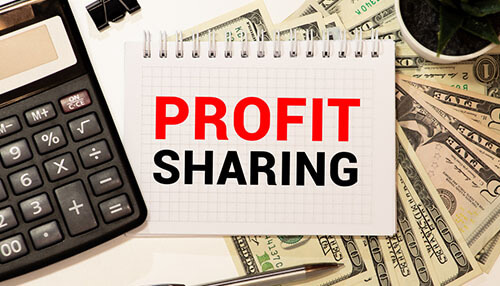Wouldn’t it be nice if everyone in the company shared in its success? After all, every person from the CEO down is a building block, no matter their role in the company’s growth. A raise would be a start, but that would be permanent and entail being selective about who deserves it. Some employees might feel left out, regardless of how much they’ve toiled.
Profit sharing, sometimes known as deferred profit sharing, may provide a viable incentive. In this arrangement, employees get a cut in the company’s profit, if it earns any. Businesses treat this as some retirement plan, the only difference being that the contributions come from profit instead of employee contributions.
As fantastic as it seems, profit sharing may come back to bite the business in the rear without proper planning. Consider following these steps for creating an adequate profit sharing plan.
1. Crunch the numbers
Any business decision, profit sharing included, requires determining if the business’ coffers can afford it. In this case, the company won’t get 100% of the profit, which might affect funding for essential functions.
A worst-case scenario is that a lack of math before executing profit sharing can lead to mismanagement. Recently, the Department of Labor filed a lawsuit against an entrepreneur couple for diverting the funds for their employees to beautification works in their office. The plan had been in place for four years, yet the Department of Labor argued that the company failed to diversify the plan.
It’s also easy to fall for a false sense of confidence, especially if the owner doesn’t consider the company’s revenues over a year. It isn’t unusual for a company to experience highs and lows, which can affect how much profit it can disburse.
Hence, before deciding to do profit sharing, study how well you can afford it.
2. Set qualification standards
Disbursing an equal share would be unfair for employees who exerted more effort than the rest. Employers must set ground rules for determining who qualifies for profit sharing and how much they can receive. While there isn’t a universal standard, here’s one good example (the rate refers to the weight, not the portion of profit):
- 50% – seniority (how long an employee has worked for the company)
- 33% – performance (how consistent an employee’s work quality is)
- 17% – profitability (how much an employee’s line of work pays)
It’s essential to have this information in writing in a profit share agreement, as with other details like the timeline and legal clauses. Owners can end up with a pile of pay disputes to settle if the qualification standards aren’t clear.
3. Choose the allocation method
It’s worth noting that there’s no single method for determining profit allocation. A humble mom-and-pop shop can’t share the same amount as a conglomerate. That’s why businesses can choose among many profit allocation methods. The three most commonly used include:
- Salary ratio – Perhaps the most basic, the salary ratio method calculates an employee’s share of profit based on their W-2 declared pay. With the profit sharing rate equal across the board, it provides the highest payout to employees, among the list.
- Permitted disparity – Also called the integration method, it entails calculating the share of profit based on an employee’s Taxable Wage Base. Experts say it’s a safe choice, as it accounts for an individual’s Social Security liability.
- Age-weighted – This method considers the employee’s age (not seniority) and income. For instance, a newly-hired clerical worker can earn the largest share of profit if they’re the oldest in the company.
When calculating, keep in mind that the Internal Revenue Service (IRS) mandates a limit on how much an employee can receive from profit sharing. For 2022, the limit is 100% of the employer’s compensation or USD$61,000, whichever is lesser. Including catch-up contributions, the limit increases to USD$67,500.
4. Communicate with employees
Once a company rolls out its profit sharing plan, there’s no turning back. Announcing the plan company-wide and backing out of that promise later is a great way to lose irreplaceable talent. Seamless communication is vital in informing employees of the bonus they may be eligible for.
The thing with profit sharing is that it requires being transparent about the company’s finances. Some business owners aren’t comfortable disclosing their numbers, but the plan will get many people more involved than before. It may also require revealing other articles like the company’s compensation management system, all to motivate employees to stay.
Conclusion
A benevolent business owner would want to provide for employees as much as possible. Profit sharing may sound good initially, but it’ll only do more harm than good if the business can’t afford it. A reasonable profit sharing plan should never make a company’s accounts go in the red, so there’s all the more reason to plan ahead and thoroughly.



